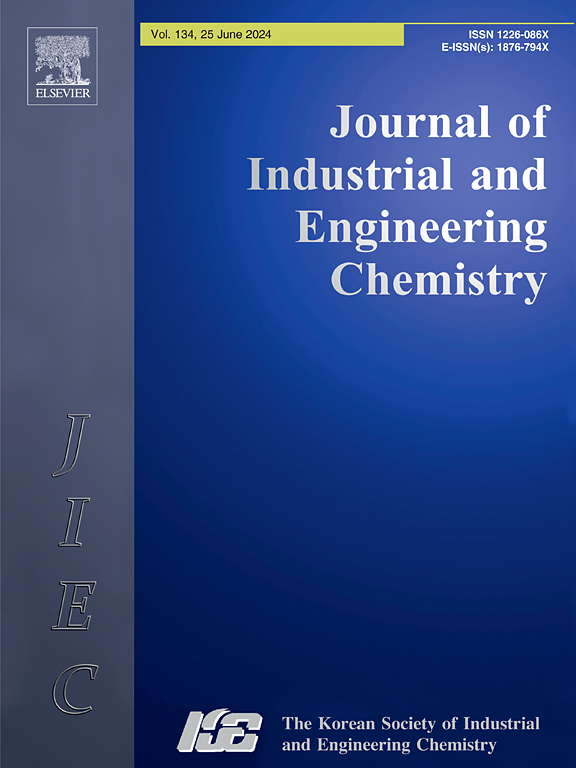Novel Schiff base derivatives: Enhanced corrosion protection for copper in NaCl solutions – Electrochemical insights and theoretical analysis
IF 5.9
3区 工程技术
Q1 CHEMISTRY, MULTIDISCIPLINARY
Journal of Industrial and Engineering Chemistry
Pub Date : 2024-11-20
DOI:10.1016/j.jiec.2024.11.039
引用次数: 0
Abstract
This study investigates the corrosion inhibition properties of two recently synthesized Schiff bases, namely 4-bromo-2-(((2-((2-hydroxyethyl)amino)ethyl)imino)methyl)phenol (BHA) and phenyl-2-(((2-((2-hydroxyethyl)amino)ethyl)imino)methyl)phenol (PHA), for copper in a 3.5 wt% NaCl solution. The novelty of this work lies in the use of these Schiff bases, which have not been previously studied in this context, thereby providing new insights into their potential as effective copper corrosion inhibitors. The inhibition performance of the Schiff bases was evaluated using potentiodynamic polarization (PDP) and electrochemical impedance spectroscopy (EIS). The potentiodynamic polarization results demonstrated high corrosion inhibition efficiencies of 85.16 % for PHA and 82.78 % for BHA at a concentration of 1 mM, indicating a mixed-type inhibition process with cathodic predominance. The adsorption of these inhibitors on the copper surface was found to follow the Langmuir adsorption isotherm, and the adsorption constants (Kads) and Gibbs free energies (ΔG*ads) were calculated. Quantum chemical calculations, in conjunction with Monte Carlo (MC) and molecular dynamics (MD) simulations, provided further insight into the adsorption mechanisms and supported experimental findings, thus offering a comprehensive understanding of the inhibitors’ efficacy.

新型希夫碱衍生物:增强对 NaCl 溶液中铜的腐蚀保护--电化学见解和理论分析
本文研究了最近合成的两种希夫碱,即4-溴-2-((2-(2-羟乙基)氨基)乙基)亚氨基)甲基)苯酚(BHA)和苯基-2-((2-(2-羟乙基)氨基)乙基)甲基)苯酚(PHA)在3.5 wt% NaCl溶液中对铜的缓蚀性能。这项工作的新颖之处在于使用了这些希夫碱,这些希夫碱以前没有在这方面进行过研究,从而为它们作为有效的铜缓蚀剂的潜力提供了新的见解。采用动电位极化(PDP)和电化学阻抗谱(EIS)评价了希夫碱的缓蚀性能。动电位极化结果表明,在浓度为1 mM时,PHA和BHA的缓蚀效率分别为85.16%和82.78%,表明缓蚀过程为阴极优势的混合型缓蚀过程。发现这些抑制剂在铜表面的吸附遵循Langmuir等温线,并计算了吸附常数(Kads)和Gibbs自由能(ΔG*ads)。量子化学计算,结合蒙特卡罗(MC)和分子动力学(MD)模拟,进一步深入了解了吸附机制,并支持了实验结果,从而全面了解了抑制剂的功效。
本文章由计算机程序翻译,如有差异,请以英文原文为准。
求助全文
约1分钟内获得全文
求助全文
来源期刊
CiteScore
10.40
自引率
6.60%
发文量
639
审稿时长
29 days
期刊介绍:
Journal of Industrial and Engineering Chemistry is published monthly in English by the Korean Society of Industrial and Engineering Chemistry. JIEC brings together multidisciplinary interests in one journal and is to disseminate information on all aspects of research and development in industrial and engineering chemistry. Contributions in the form of research articles, short communications, notes and reviews are considered for publication. The editors welcome original contributions that have not been and are not to be published elsewhere. Instruction to authors and a manuscript submissions form are printed at the end of each issue. Bulk reprints of individual articles can be ordered. This publication is partially supported by Korea Research Foundation and the Korean Federation of Science and Technology Societies.

 求助内容:
求助内容: 应助结果提醒方式:
应助结果提醒方式:


